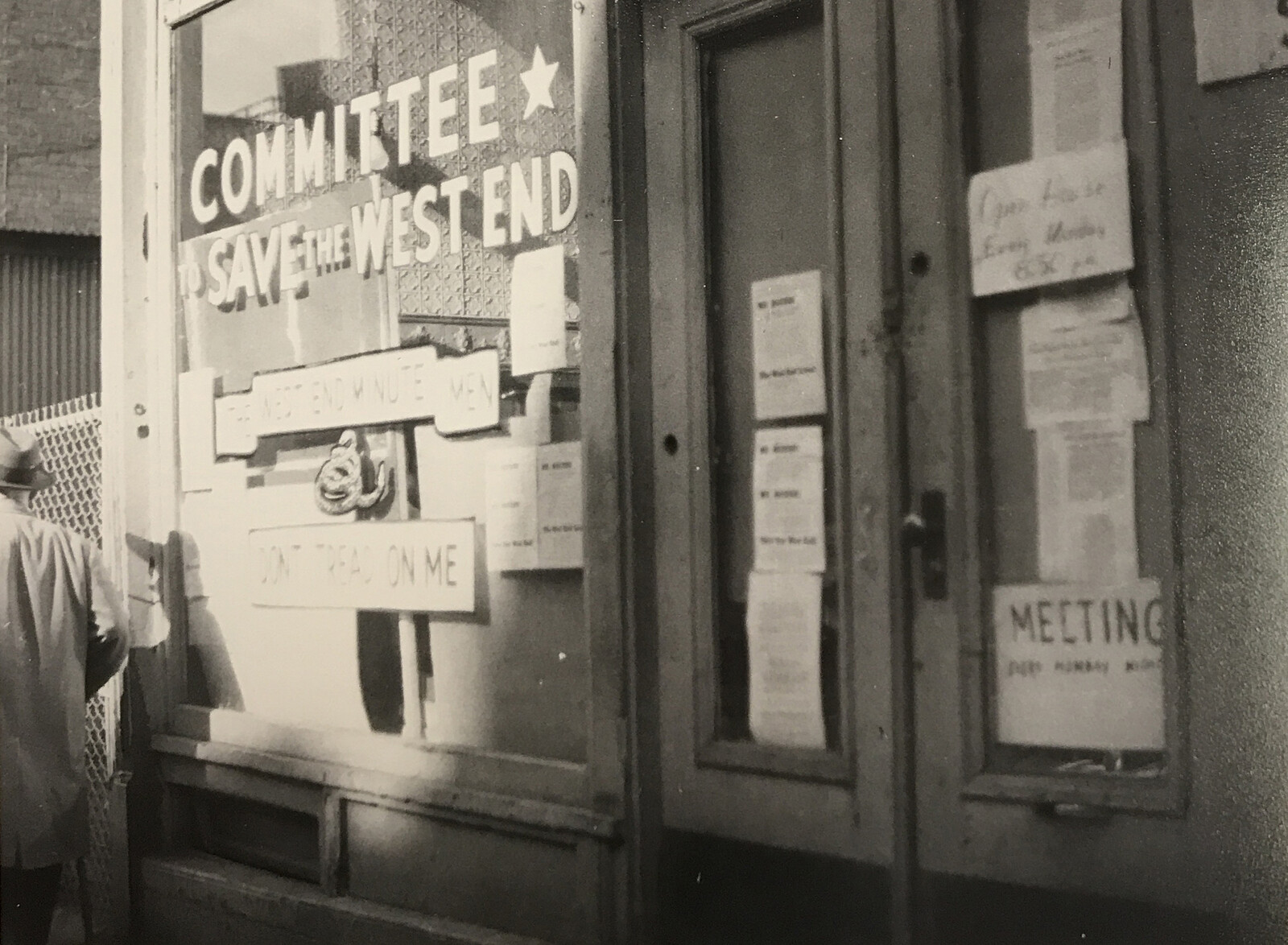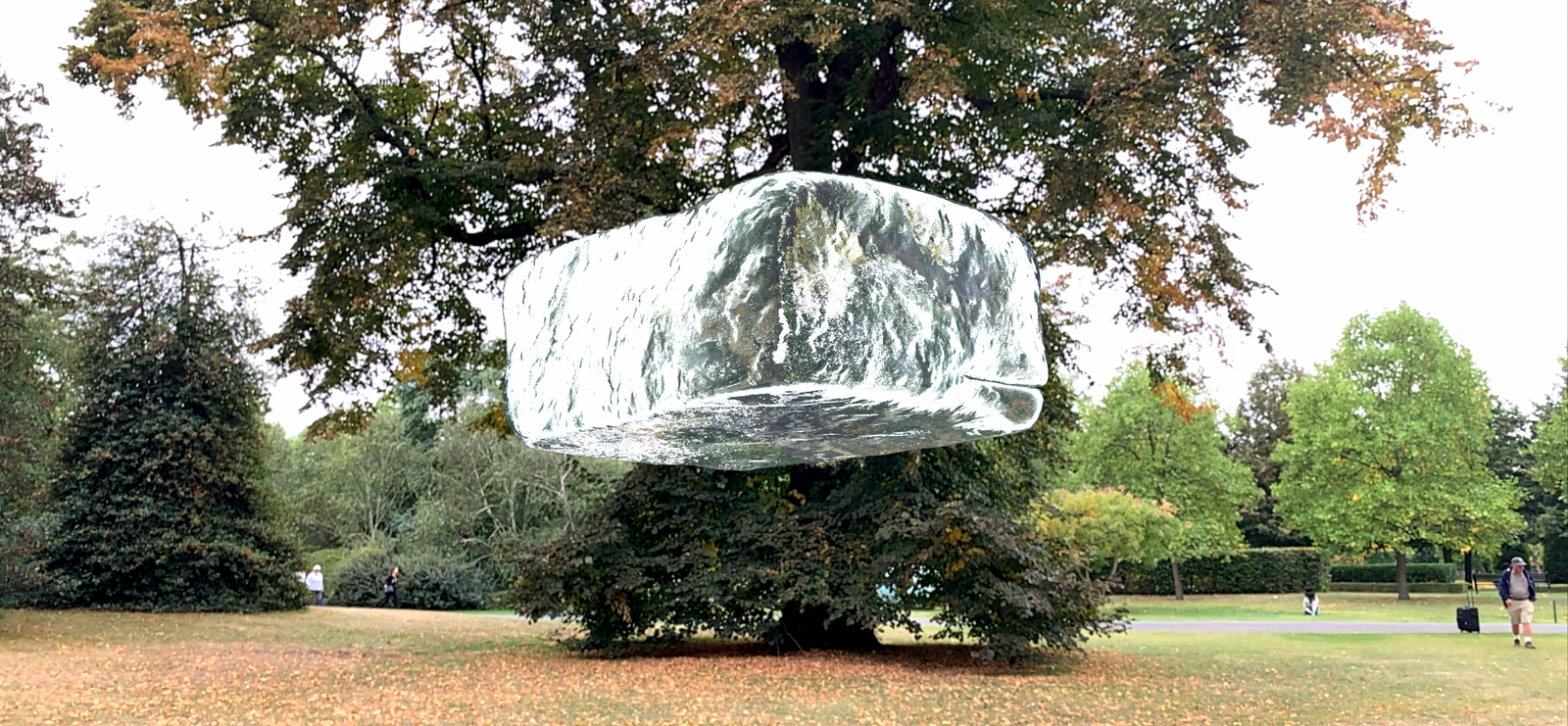Networks and Society
Whether it is online or in our daily physical routines, we interact with others—close friends, acquaintances, familiar and unfamiliar strangers—in ways that over time come to show patterns. Network theory represents these relationships as graphs, using the visual language of ties (lines) connecting nodes (circles) to describe the topography and dynamics of families, friendship groups, workplaces, neighborhoods, and communities. By representing complex systems as graphs, network science allows us to link micro and macro phenomena: to understand how ideas and things are transmitted and disseminated, or travel and spread.
Since it was first theorized in 1973 by economic sociologist Mark Granovetter, the concept of “weak ties” (connections between acquaintances) rather than “strong ties” (connections between friends) has been foundational to understanding how information and influence travels within networks.1 The concept is central to current social media sites such as LinkedIn, a professional networking platform with more than 690 million users, which cultivates and capitalizes on weak ties to help users find jobs. They are also key to seemingly more intimate sites: Facebook, for instance, which describes users as “friends,” has used an analysis of weak ties to explain how its users gain novel information from contacts with whom they do not often interact.2
Granovetter’s hypothesis of the “strength of weak ties,” like other central network science concepts such as homophily, drew from ethnographic studies within mid-century urban sociology. If homophily, the idea that similarity breeds connection, underlies the polarization that occurs in many online networks, weak ties can be used to combat polarization and acknowledge—even activate—the fact that we live in a world of difference.3 Weak ties offer a way to engage the rich ambivalence that pervades everyday interactions with acquaintances.
Micro Connections, Macro Phenomena
In “The Strength of Weak Ties,” Mark Granovetter argued that weak ties are paradoxically strong because they connect disparate individuals and communities. His positive evaluation challenged the conventional wisdom about “good” ties within networks and positive social relationships in cities. At the time Granovetter was writing, the prevailing scholarship in urban sociology had viewed weak ties as evidence of social alienation in cities. Drawing from this, researchers developed models that assessed the importance of nodes according to their centrality, that is, the number of ties they had.4 In contesting this line of thought, Granovetter not only overturned standard ways of measuring the social health of communities, but also emphasized quality over quantity of information. He argued that “novel” information—news not already known within one’s group of closest friends—was most useful during critical moments, from looking for a job to organizing for political action.
Granovetter used four factors to determine the strength of social ties: the “amount of time, the emotional intensity, the intimacy (mutual confiding), and the reciprocal services.”5 A weak tie therefore is not intense, nor intimate, nor reciprocal, and this, Granovetter argued, perversely makes them valuable in that they tend to “bridge” individuals or groups who are dissimilar. Bridges, he argued, are ties that cross different clusters in a network and serve as the only point of connection between them. Close friends with strong ties spend time together, intensely, and often share sources of information, leading to the possibility of becoming “trapped” in their tightly-knit groups. The claim that weak ties have “strength,” then, refers to the idea that, on the individual scale, having many acquaintances or casual connections (rather than only close friends) helps individuals access a more diverse range of information and set of opportunities. On the macro scale, similarly, the presence of “weak ties” in a community enhances its cohesion and also helps to connect subgroups to larger networks of power, information, and influence. Granovetter used the word “cohesion” to describe the resilience, flexibility, strength, and capacity of a community.
Operating at both the micro and macro levels, the notion of weak ties has proven essential to the structural analysis of social networks. Granovetter argued that large scale social phenomena—such as “diffusion, social mobility, political organization, and social cohesion in general”—are influenced by the structure of social connections between individuals.6 While his analysis was a qualitative assessment of the nature of ties, quantification was intended as a not so distant possibility. In the conclusion to his 1973 paper, Granovetter observed that “a mathematically inclined reader will recognize the potential for models.”7
The enduring power of weak ties stems from the claims made by Granovetter about their ability to determine the success—or failure—of individual and group action. In order to define weak ties, Granovetter leveraged the structural properties of communities derived from ethnographic data to make an argument about the physics of interpersonal ties. He contends that these ties have the power to shape the topology of a network at large and determine the fate of that network. Specifically, in describing the role that weak ties can play within communities, Granovetter based his analysis on the histories of urban renewal plans in two neighborhoods in Boston, as told through two different ethnographic accounts. Granovetter argued that a lack of weak ties explained why the West End was unable to stop its demolition under urban renewal in 1957, while Charlestown residents were able to turn back the bulldozers in 1965.8
Networks and Cities
In the middle of the twentieth century, Boston’s West End was a predominantly white, working class neighborhood full of tenement apartment buildings and small businesses. The area had a large proportion of foreign-born residents (27% in 1950) who hailed primarily from Italy, the Soviet Union, and Poland. The neighborhood’s location—in central Boston at the mouth of the Charles River, near to the affluent Beacon Hill area and immediately adjacent to the Massachusetts General Hospital campus—made it an appealing target for demolition when federal funding for “slum clearance” and urban “renewal” became available in 1949. It was one of the first neighborhoods in Boston to be singled out for demolition, with plans to displace nearly all of the current residents and build new apartments for new residents. After a series of studies beginning in 1950, and despite objections by residents, bulldozers arrived in 1957.
Reading this history, as laid out in Herbert Gans’s landmark study The Urban Villagers: Group and Class in the Life of Italian-Americans, Granovetter argues that the residents failed to organize its various social groups into a cohesive resistance to the urban renewal plans for the neighborhood because they lacked weak ties. He claimed that the social lives and tightly knit groups of West End residents exhibited strong ties, which paradoxically led to fragmentation when the neighborhood is viewed as a whole. He also suggested that Gans might not have grasped these network dynamics because as a participant observer on the ground, he missed what only became visible in a bird’s eye view.
In a short aside, Granovetter contrasts the fate of the West End with that of Charlestown, a neighborhood across the Charles River which was able to organize against urban renewal in 1965:
The case of Charlestown, a working-class community which successfully organized against the urban renewal plan of the same city (Boston) against which the West End was powerless, is instructive in this respect: unlike the West End, it had a rich organizational life, and most male residents worked within the area.9
Granovetter’s writing ignores the economic and often racialized violence at the heart of urban renewal, and instead blames the demolition of certain neighborhoods on the residents who were displaced. Revisiting the planning documents which enabled the demolition of the West End reveals how predetermined the fate of the West End was from the outset. For example, Granovetter does not mention that the Charlestown plans were overturned more than ten years after the initial demolition plans for the West End were drafted. And he concedes that his theory is an interpretation rather than a definitive quantitative analysis. He notes that:
in the absence of actual network data, all this is speculation. The hard information needed to show either that the West End was fragmented or that communities which organized successfully were not, and that both patterns were due to the strategic role of weak ties, is not at hand and would not have been simple to collect.10
Even as speculation, however, the links that Granovetter makes between network structure, political organizing, and urban renewal merit further investigation.
Network Ethnography
Herbert Gans’s work on the West End was not a formal study of the structure of social networks in the way Granovetter later appropriated it. However, the ways in which Gans gave generalized descriptions of the community structures he observed made his work especially apt for Granovetter’s later application.
Gans began studying the West End in response to the urban “renewal” plans for the neighborhood initially announced in 1950. At the time, he was a faculty member affiliated with the Harvard Center for Community Studies, and was helping to lead a project called “Relocation and Mental Health: Adaptation Under Stress,” which aimed to understand the impacts of urban redevelopment and relocation on “working- and lower-class society and life.”11 In other words, Gans chose the West End specifically because the prospect of its demise provided a unique opportunity to study the psychological impacts of housing relocation projects. Gans lived as a participant observer in the neighborhood, renting an apartment in the West End from October 1957 to May 1958 and immersing himself in the community.
For Gans, “one of the original reasons for making a study was to discover how the West Enders as individuals and as a community were reacting to the eventual—and then imminent—destruction of their neighborhood.”12 However, upon moving to the neighborhood, Gans found that the West Enders did not exhibit “the expected stress.” Instead, they “continued to follow their normal routines.”13 This led his book to become a study of everyday life and social structures among the Italian residents of the West End, and only contained a brief account of actions surrounding redevelopment in an epilogue.14
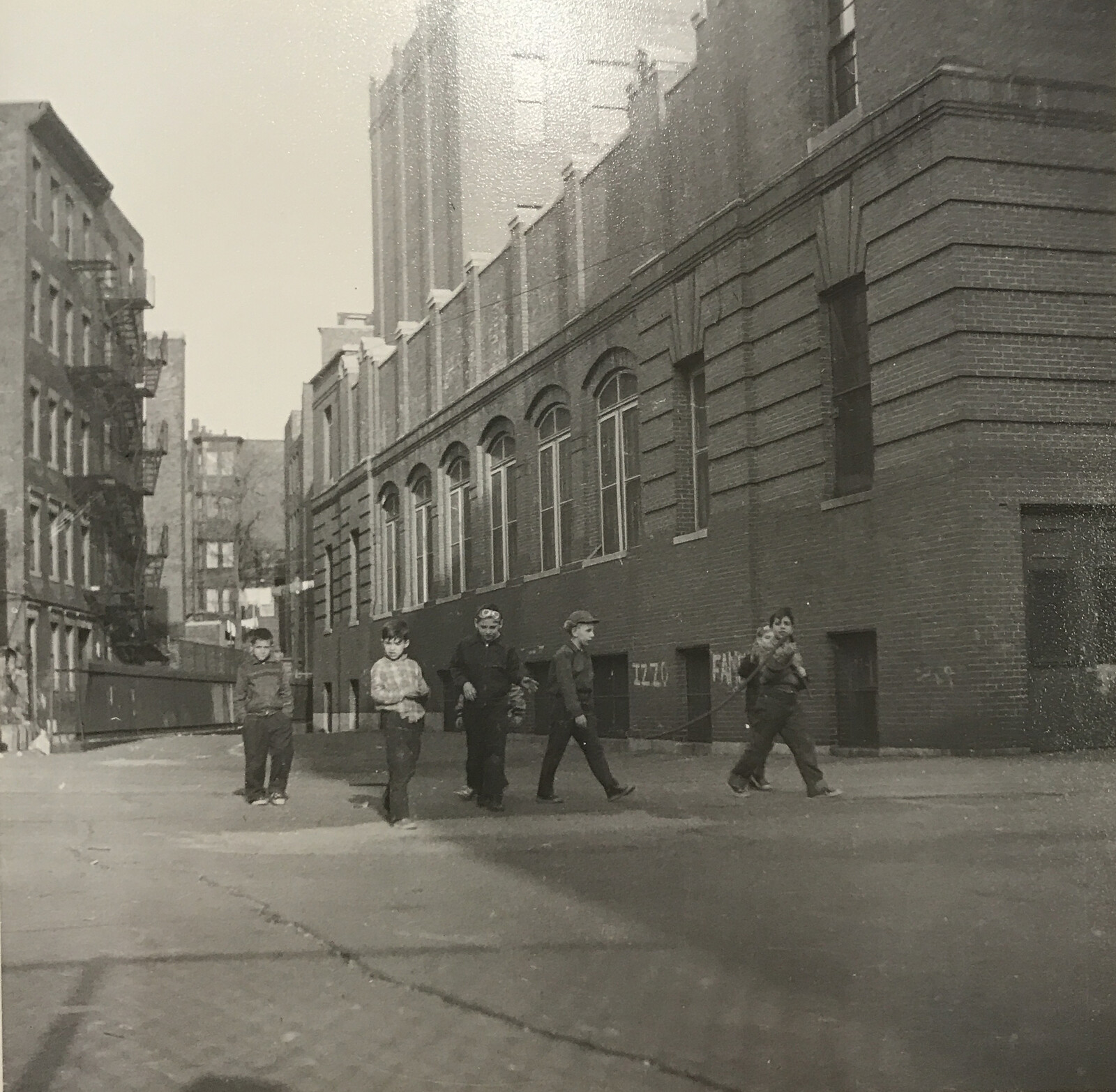
Selected photographs of the West End by Herbert Gans, c. 1957. Herbert Gans papers, 1944–2004, Columbia University Rare Book & Manuscript Library.
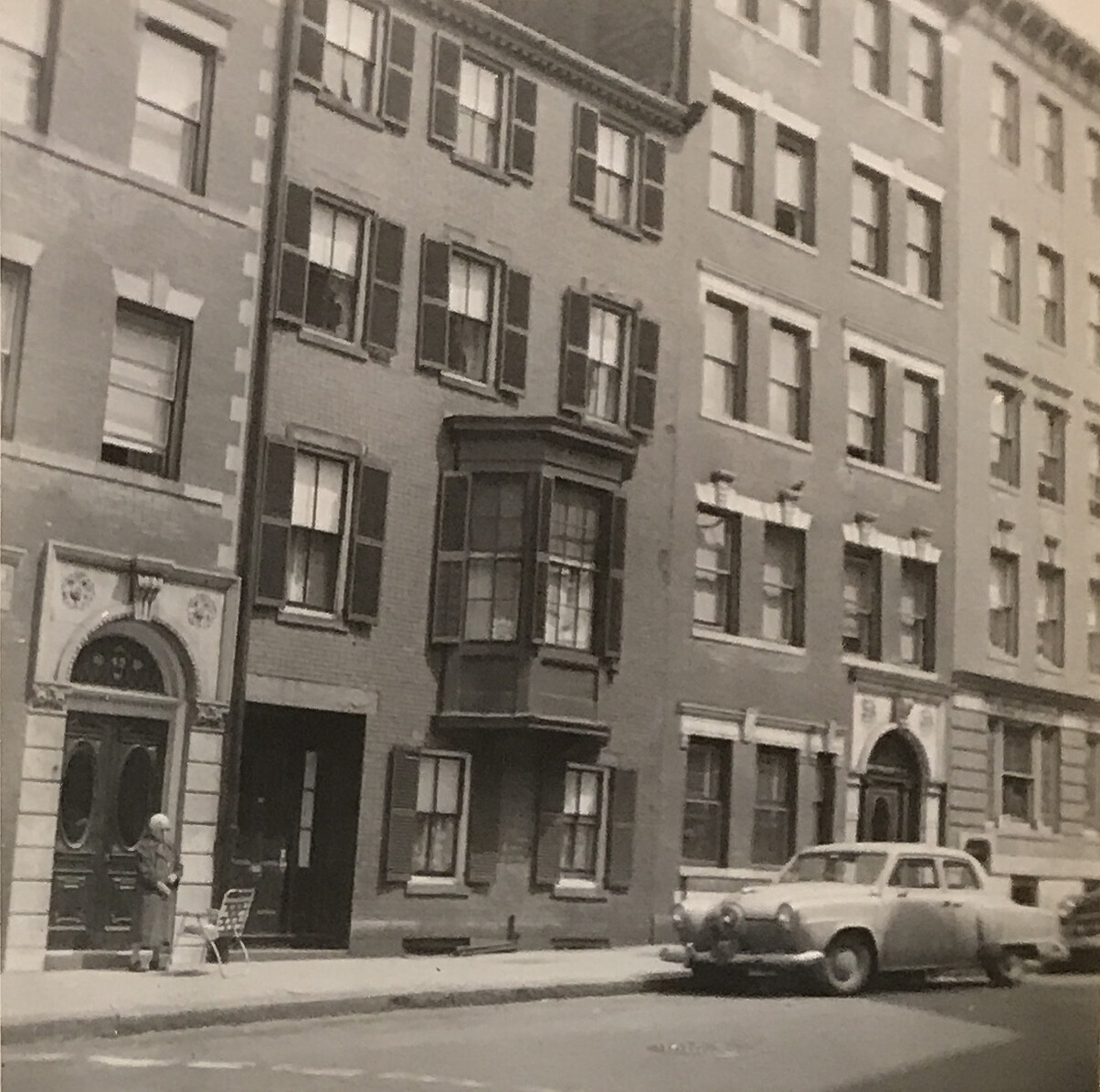
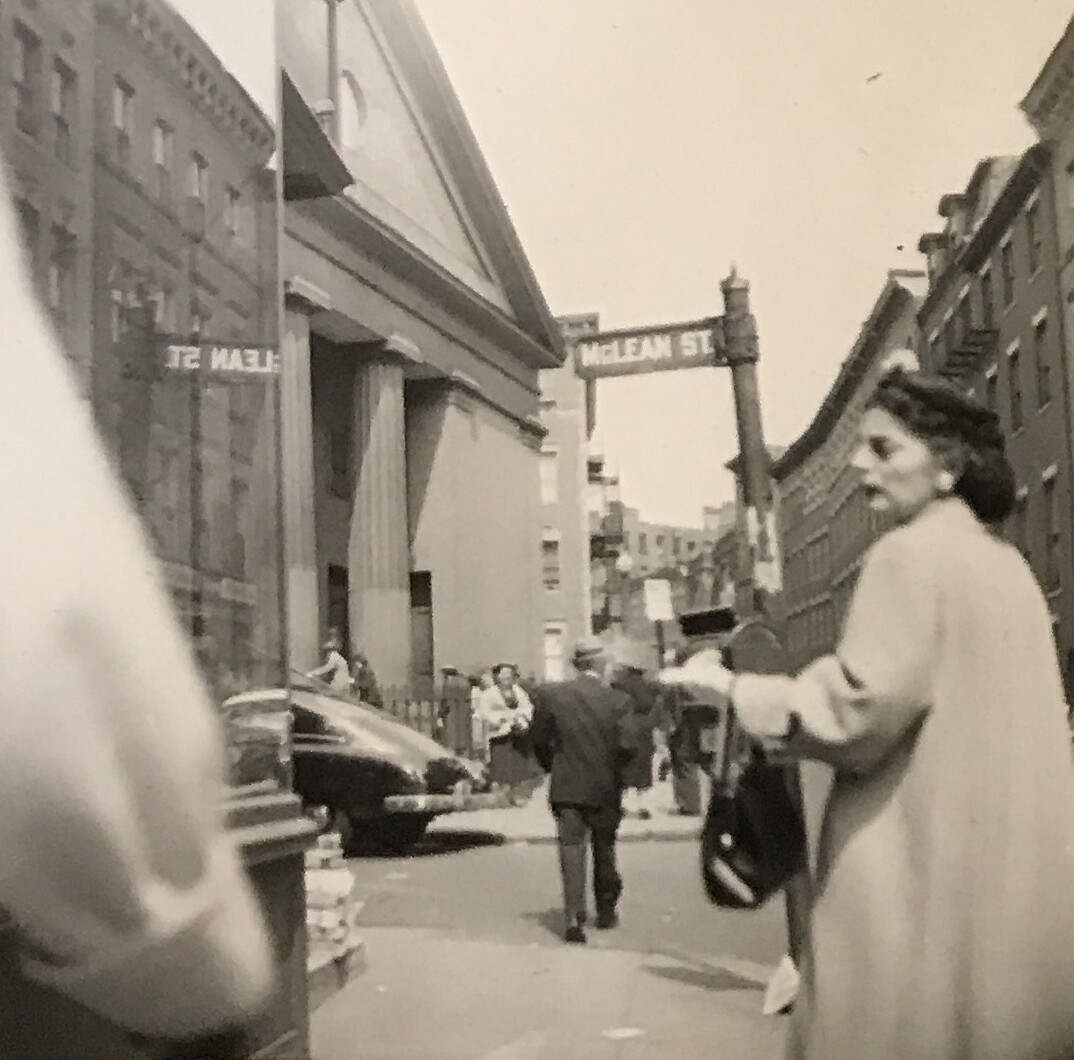
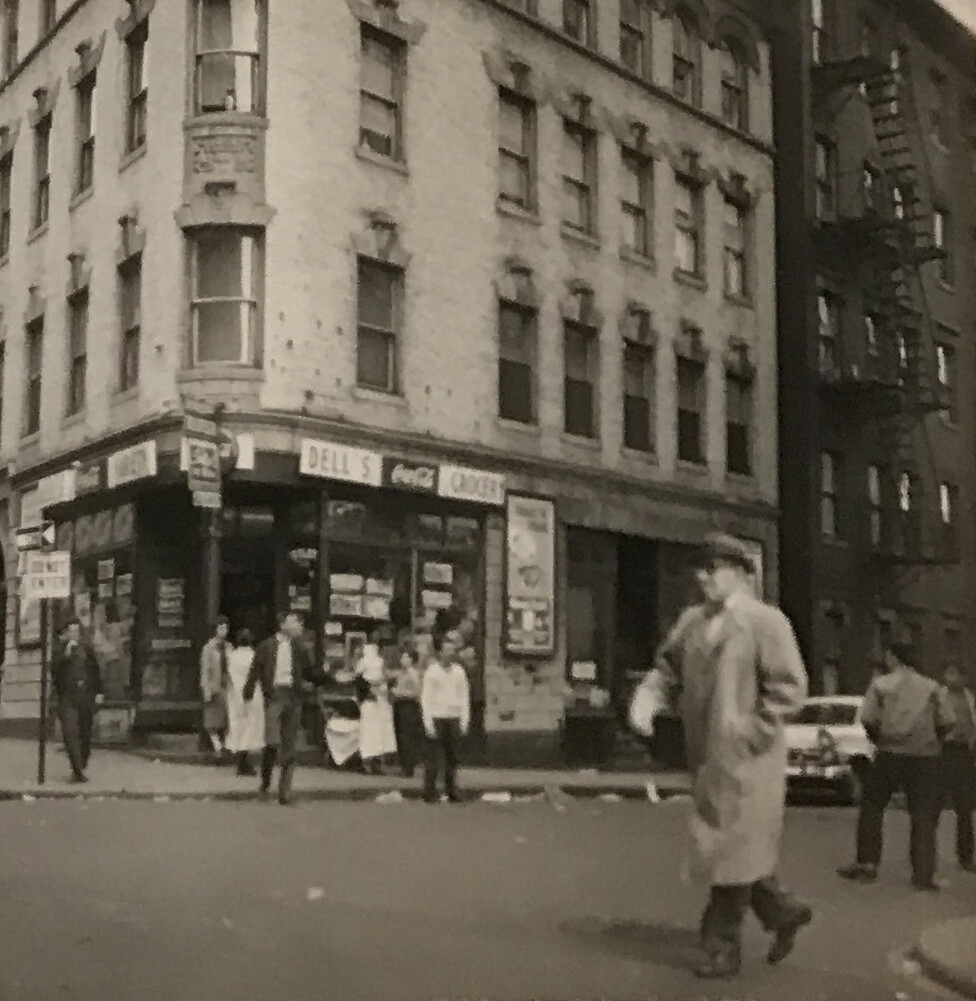
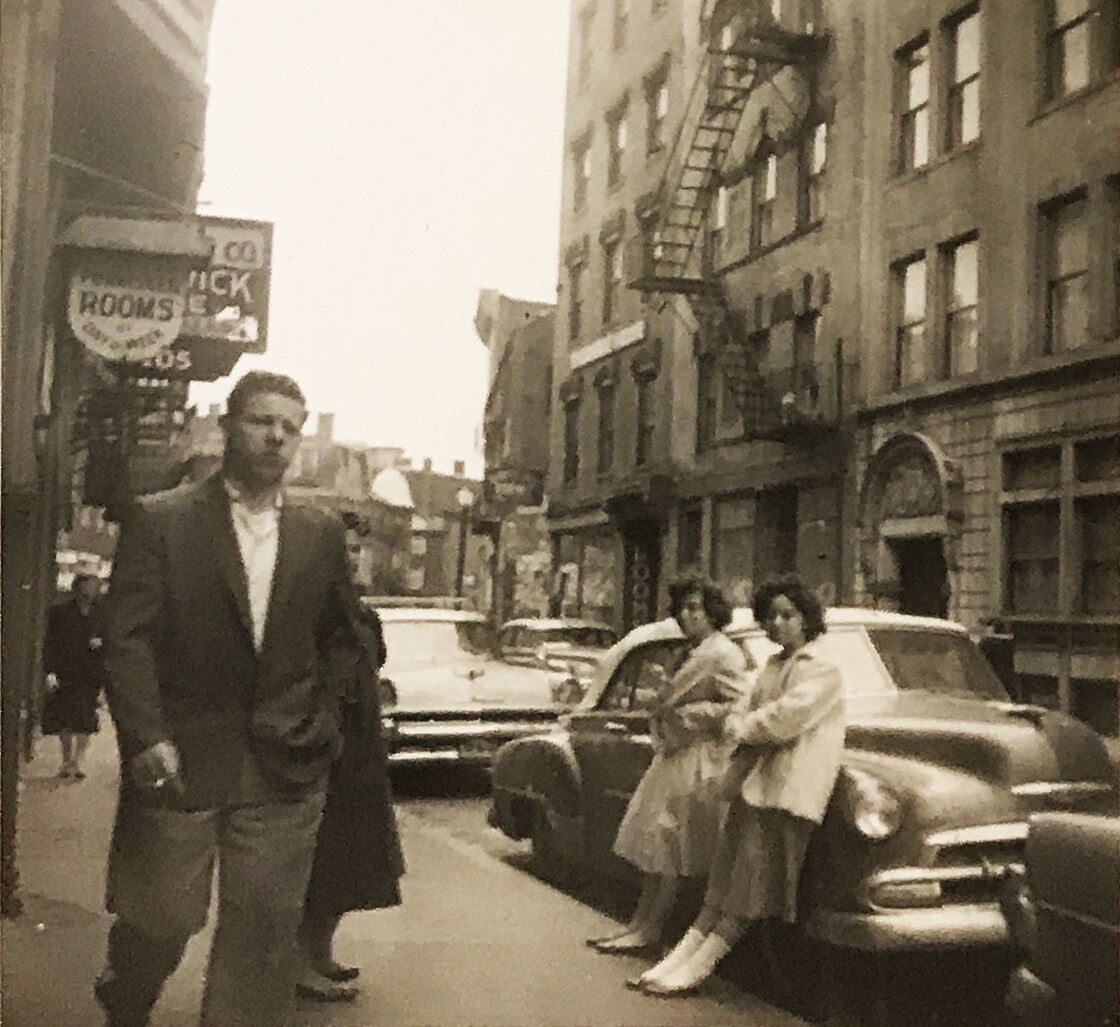
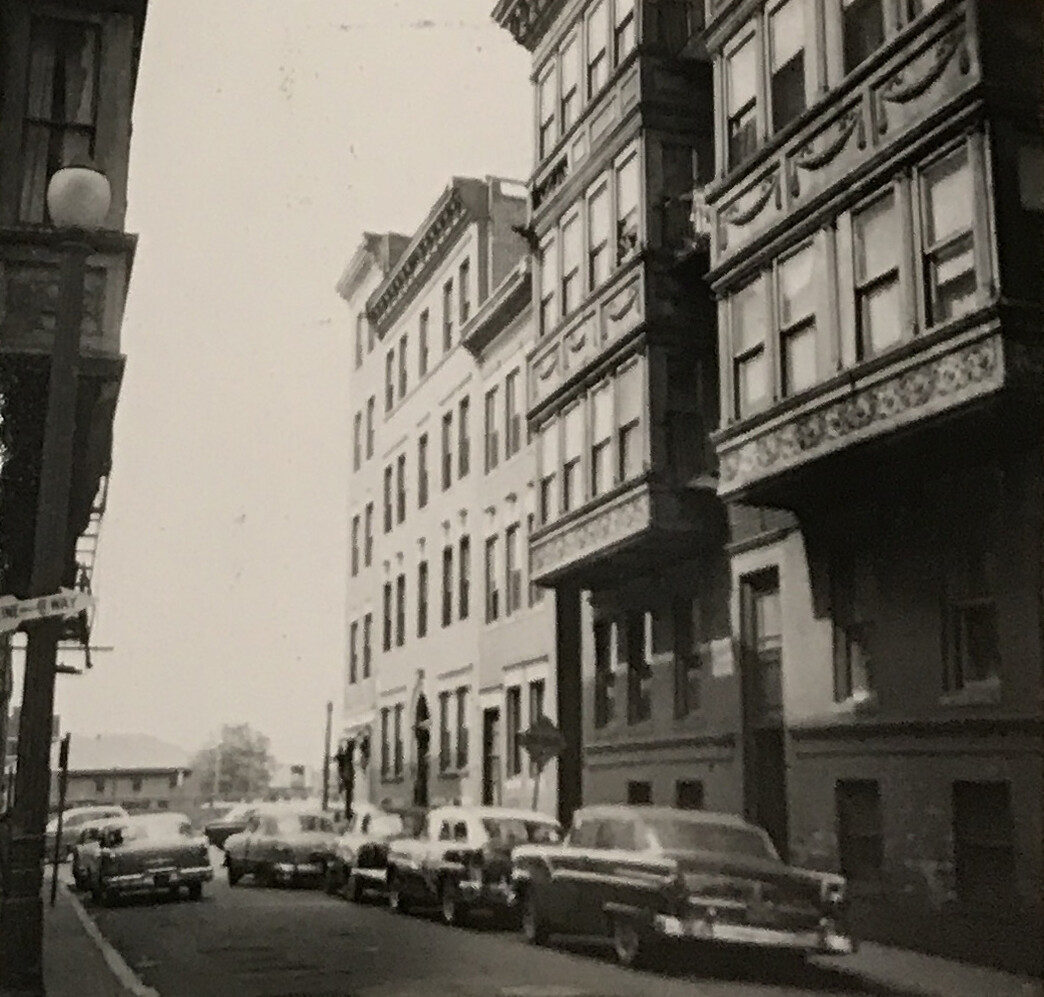


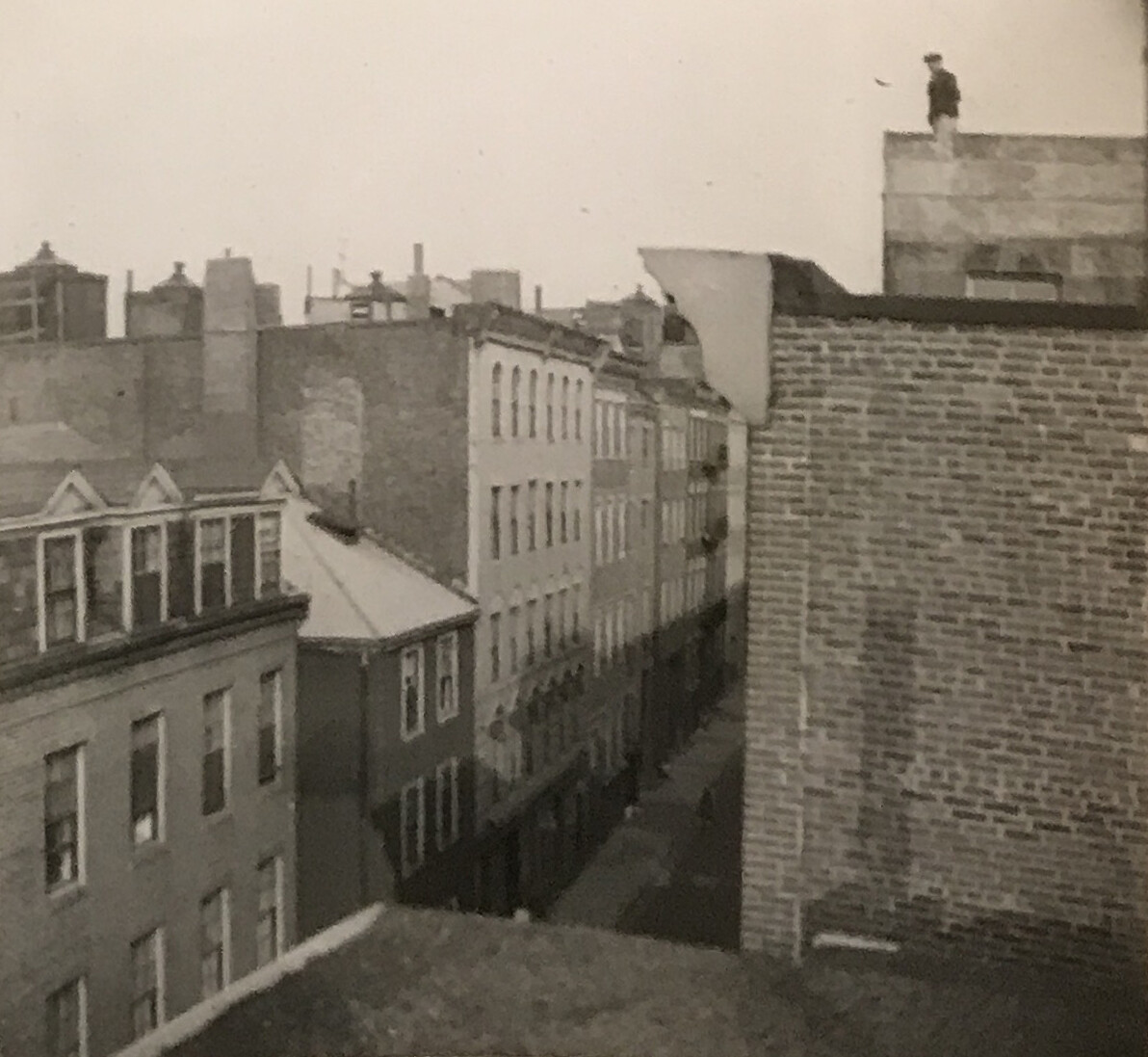
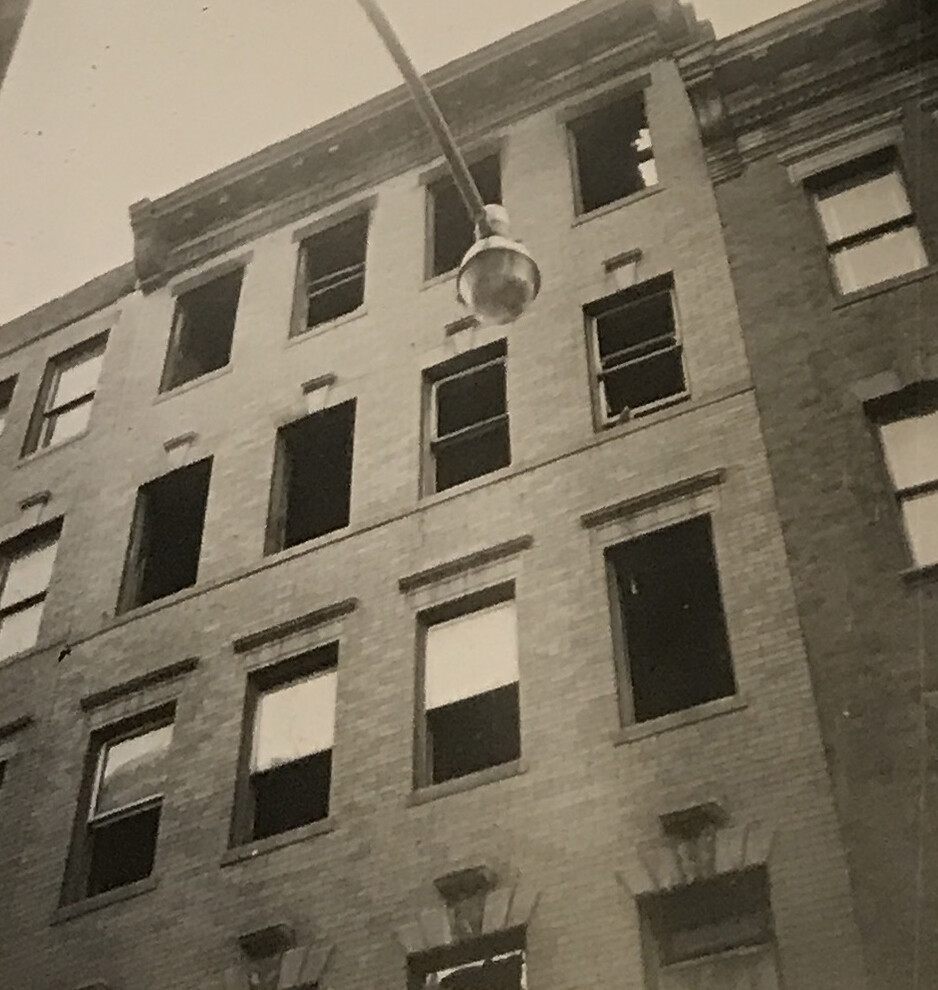



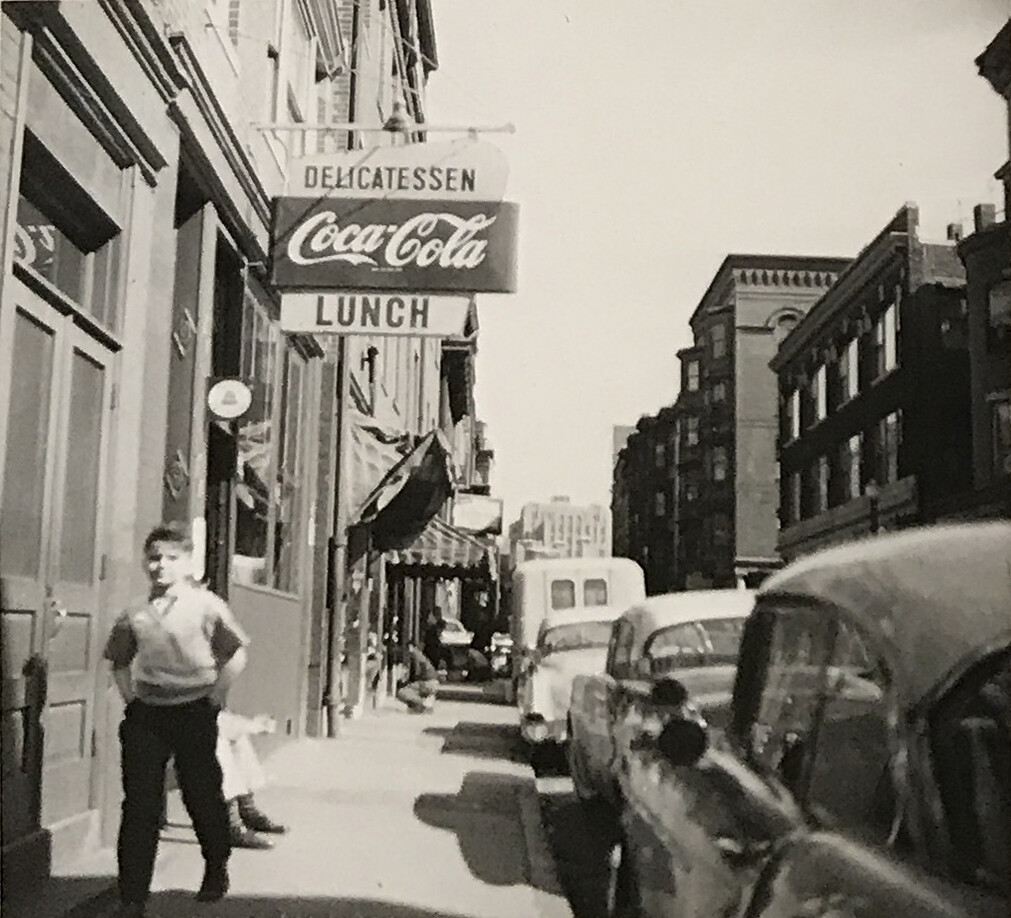
Selected photographs of the West End by Herbert Gans, c. 1957. Herbert Gans papers, 1944–2004, Columbia University Rare Book & Manuscript Library.
The majority of Gans’s empirical work focused on understanding what he termed the “peer group society” in the West End. This “peer group” is a social form that Gans described in direct contrast to white middle class forms of organizing social life consisting of “entertaining and party-giving.”15 Instead, West Enders cultivated and belonged to a close-knit group of family and friends of approximately the same age that were formed in childhood. “West End, in effect, may be viewed as a large network of these peer groups, which are connected by the fact that some people may belong to more than one group. In addition, a few individuals function as communicators between the groups, and thus keep them informed of events and attitudes important to them all.”16 The risk of losing contact with or the ability to participate in these peer groups was one of the fears Gans described West Enders having at the prospect of urban renewal.
Gans’s descriptions often focused on the connections between West Enders, and followed the ways those connections formed and changed at different stages of life. Gans observed that children quickly formed friendships (through playing in the streets and other public spaces); that they nurtured and spent more time engaging with friends than they did with their parents; that friendships were largely divided by gender except in the case of married relationships; and that at the time of marriage a couple withdrew from the peer group society for a time, and then re-entered with each member of the couple having largely separate networks of friendships. His descriptions were appealingly (and at times problematically) simplified and abstract. He took individual situations from his field observations and used them as the basis for descriptions of the generalized dynamics, formation, and structure of relationship groups. These generalizations, specifically of the tightly-knit structure of peer groups, is used as evidence by Granovetter to conclude that the social structure of the West End lacked weak ties, and to formulate the theory of weak ties in communities.
Networks or History
Although Gans’s ethnography emphasized connections between different social groups, he felt that Granovetter had misunderstood him entirely. One year after the publication of “The Strength of Weak Ties,” the two published their correspondence in the American Journal of Sociology in the form of a debate about the applicability of Granovetter’s weak ties theory to what Gans’s ethnographic work revealed about the West End.17
Gans argued that cultural, historical, and political factors were more important in explaining the lack of successful resistance to urban renewal in the West End than were network structures. He points out that at the time of its demolition, there had not yet been any examples of successful organizing against urban renewal in Boston. Indeed, the West End served as a cautionary example for mobilizing later resistances to urban renewal—most notably in Charlestown, Granovetter’s counter-example, which won its battle against urban renewal. The political context of the West End also contributed to the lack of successful resistance, with major neighborhood institutions supporting the demolition plan and widespread distrust of local politicians by residents. Granovetter contended that even had there been precedents for successful anti-renewal organizing, and a broader public consciousness that resistance to urban renewal was possible, the network structure that Gans had observed would likely prohibit a community like the West End from organizing.
To evaluate this debate further, it is important to situate the West End project in the histories of urban renewal in Boston. Title I of the Housing Act of 1949 made federal funding available to cities and authorized the use of eminent domain for “slum clearance” projects to address issues of “blight” in urban centers.18 In order to receive these federal funds, cities were required to adopt a general plan, and then to designate “renewal” areas that supported the goals of that plan. In 1950, Boston’s City Planning Board published such a “General Plan,” which described trends and goals for the city, mapping out directions for the growth of residential, commercial, and industrial areas. Consistent with the views of most city planning departments at the time, the document argued that:
the urgency of clearing the city’s slums is generally accepted…these are areas that are a liability to the community as a whole, in every sense. Statistical studies…show them to be breeders of juvenile delinquency and crime, centers of social and family disorganization…High rates of disease and death can also be traced to slum conditions.”19
The Plan featured a two-page spread singling out the West End, naming it “An Obsolete Neighborhood.” The only such spread in the nearly ninety-page document, it showed a map and key statistics about the West End alongside a map of a proposed redevelopment plan. Of the present conditions in the West End, the planners concluded that “such an environment undoubtedly impairs the mental and physical health of its inhabitants.”20 Their proposal envisioned a new neighborhood in which “building coverage is reduced by 68% but with only 40% fewer families.”21
Based on this, the Boston Housing Authority (BHA), which was in charge of all the city’s redevelopment and clearance projects, requested funding through Title I of the Housing Act of 1949 to conduct a planning study of the West End, along with areas in the South End and Roxbury.22 The report on the New York Streets area of the South End was released in 1952 and declared the area as “blighted.” In a 1953 report on the West End, the BHA declared that the neighborhood was in “dire need for redevelopment” and noted that it had already been identified in the General Plan for Boston. Further studies were conducted on the neighborhoods to outline demolition plans, and with federal Title I grants secured, demolition began for New York Streets in 1955, and for the West End in 1957.
The early and mid 1950s was a period characterized by widespread agreement among architects, urban planners, government officials, and politicians on the merits of such “clearance” projects. Major demolition projects were underway in cities like Washington DC, New York, Boston, and Pittsburgh. And in 1954, the government’s right to take land declared as “blighted” via eminent domain in order to facilitate new private development was upheld by the US Supreme Court in the landmark Berman v. Parker decision.23
Just a few years later, though, when plans for redevelopment in Boston’s Charlestown neighborhood were made public in 1963, public consensus had begun to shift. A decade after the announcement of plans to demolish the West End, a new consciousness had begun to emerge around the negative impacts of urban renewal. Struggles like those of the West End in Boston or Lincoln Center in New York City served as lessons for communities faced with urban redevelopment plans.24 Within academic planning and sociology spheres, work like that of Gans—offering alternative views of the social life of urban slums—began to complicate narratives of blight. Jane Jacobs even references the West End’s story as contributing to her views of urban renewal. Recounting hearing from City photographers that planning officials used misleading photographs taken of attics rather than apartments to show deteriorated housing conditions and designate the West End as a “slum,” Jacobs declared: “I too had become outraged.”25
Arguably, Granovetter might not have been able to imagine resistance to urban renewal as a goal around which communities could organize had it not been for later struggles against demolition (like those in Charlestown), which had learned from the plight of the West End. Further, Granovetter’s argument to a certain extent blames West End residents for the destruction of their own community, when history clearly shows that the neighborhood’s destruction was assumed by the City of Boston, and was supported by mandates and funding from the Federal government. However, in responding to Gans’s argument that historical and political factors likely explained the experience of the West End more than network ones, Granovetter acknowledged that they are in fact interdependent:
In general, I agree with Gans on the importance of considering historical and political factors, but these are not independent of network factors, and they are not considerations of a different order…To the extent that network structure is not predictable from historical or political factors, it is especially important to take the structure into account, since it is likely to affect the situation in unexpected ways.26
Nevertheless, Granovetter maintained that network factors might bring new insights not visible through political and historical lenses.
Neighborhood Defined by Urban Renewal
Granvoetter’s “network factors” are in part dependent on the way that he defined the network. Gans pointed out that the neighborhood unit that Granovetter used to explain the residents’ failure to mount meaningful resistance to urban renewal was itself a product of the urban renewal plan. So even if “network structure is not predictable from historical or political factors,” the boundaries considered for that network are.
Writing in 1973, almost fifteen years after the destruction of the neighborhood, Granovetter’s analysis took the West End as a discrete entity. He argued that the structure of this community (fragmented into closed, tightly-knit, strongly-tied islands) was to blame for the failure to stop the urban renewal plan that would destroy the neighborhood. This view is premised, however, on the notion that the West End was, in its entirety, a community. In their debate, Gans argued against this:
In fact, the West End as a neighborhood was not important to West Enders until the advent of redevelopment. Early in my study, for example, when asking people why they liked the West End, I expected emotional statements about their attachment to the area. I was always surprised when they talked merely about its convenience to work and to downtown shopping. Then, after I had lived in the area a few weeks, one of my neighbors remarked that I knew a lot more about the West End than they did. This led me to realize that there was relatively little interest in the West End as a physical or social unit. West Enders were concerned with some of the people who lived in the area, but not with the entire population. Their interest in the physical features of the area was limited generally to the street on which they lived, and the stores which they frequented. This fact was illustrated by the fact that during the past election campaigns, politicians made a somewhat different speech on each street, filled with promises of what they would do for that street if elected.
Indeed, only when the outside world discovered the West End and made plans to tear it down did its inhabitants begin to talk about the West End as a neighborhood, although, of course, they never used this term.27
The “West End” did not exist, in other words, until it was targeted for destruction. It was not a place with which residents identified until plans for urban renewal were well underway. The neighborhood unit was politically defined, not a natural pre-existing condition.
From within the vantage point of a West Ender—a retrospectively inappropriate term, given Gans’s response to Granovetter—the network structure might look quite different. The structure observed in a network is dependent on the geography or vantage point from which it is viewed, and different perspectives will lead to vastly different conclusions. Granovetter himself speculated that the West End might have been composed of groups existing side by side, forming a neighborhood of many cliques (friends with strong ties) with few connections (weak ties) between them. But this view neglects to ask who defined the area as just one neighborhood, and instead blames residents for the destruction of their homes.
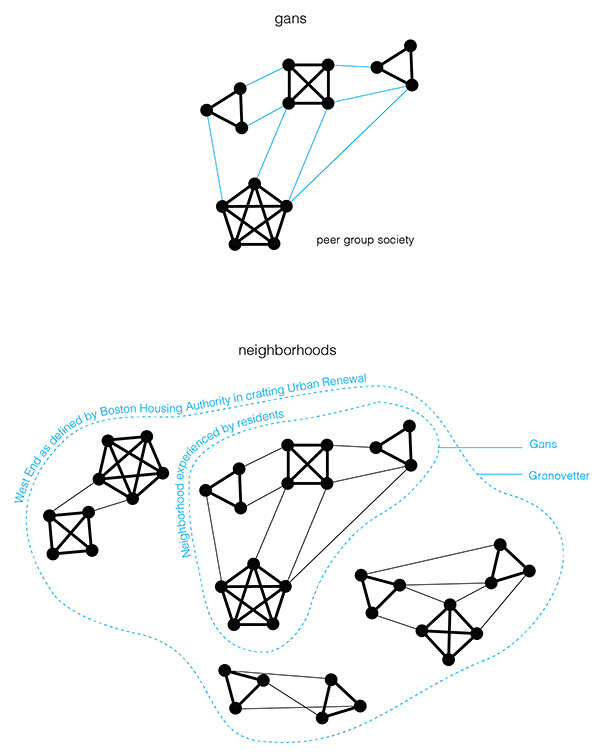

The networks of the West End. Image by Center for Spatial Research, 2020.
Differences Across Connections: Connections Across Difference
The historical and political context of Boston in the 1950s complicates the argument that a lack of weak ties was to blame for the West End’s destruction by urban renewal. More recent scholarship on the use of weak ties by different social groups also highlights complexity in the impacts of weak ties, and how weak ties are not independent of socioeconomic and racial dynamics. In an abstract model of weak ties, without politics or inequality, and viewed from above, opportunity would seem to travel along virtually frictionless paths in all directions.28
In concluding his original paper, Granovetter points to the limitations of his theory by posing a series of questions that complicate the evaluation of “strength” in weak ties. In particular, Granovetter noted: “Treating only the strength of ties ignores, for instance, all the important issues involving their content.”29 In other words, the complex set of conditions under which exchanges would occur cannot be articulated using the simple terminology of strong and weak nor the binaries put forth by structural analysis. The study therefore presumes the occurrence of this exchange and therefore the activation of the social tie. In reality however, the mere existence of a social tie does not automatically mean that it can be activated, which is to say, put into effect or utilized.
A recent paper on job search processes in an unnamed Midwestern city illustrates that weak ties do not have universal effects, but rather are conditioned upon broader racialized power dynamics. Sociologist Sandra Smith’s 2005 study of job seeking among the black urban poor addressed the issue of activation of ties, bringing together the structure and content of a network to create its most effective use. She found that for some, in job finding, access is more complicated than simply having or using a connection or observing the existence of a tie. The utilization of one’s social ties requires something beyond the mere existence of a connection. Ties must be activated as well.
For the subjects Smith studied, existing structures that connect job seekers to job referrers or providers are sometimes difficult to utilize. Her findings indicated that the social capital deficiencies of the black urban poor may have less to do with lack of access to mainstream ties than previously thought. Instead,
the inefficaciousness of job referral networks appears to have more to do with functional deficiencies—the disinclination of potential job contacts to assist when given the opportunity to do so, not because they lack information or the ability to influence hires, but because they perceive pervasive untrustworthiness among their job-seeking ties and choose not to assist.30
As Smith observed, when people share ties, often not enough effort is made to activate them. A person may not be able to mobilize or activate a tie if the person at the other end has chosen not to participate. This phenomenon described by Smith is a useful example of what Granovetter points to as a limitation in his own work, namely that the effectiveness of information traveling through a network is dependent on activating the connection, which cannot be presumed.
The obstacles faced by job-seekers in Smith’s study point to the fact that activation also has a cost. In a 2010 article on the relationship between social media and social change, Malcolm Gladwell explained how the price of utilizing ties might be determined. He proposed that the strength of a tie seems to be intrinsically connected to the size of the sacrifice that can be extracted or even demanded from those bound by it. While weak ties can reach farther across a network than strong ties, they also solicit proportionally smaller contributions in terms of time and effort—weak sacrifices—that are often too small to be able to generate meaningful personal or social change. This echoes Smith’s observation about the discrepancy between the structural and functional meaning of weak ties. Ties only become meaningful when activated. Ties of all strengths can form as an artifact of experience, but activation requires mutual acknowledgement, and sometimes sacrifice.
Graphing Connection
Granovetter’s original paper coincided with developments both in graph theory and the quantitative social sciences. Since the 1950s, there had been growing interest in utilizing graph theory—the formal study of the shape of the relationships between people in terms of the ties and nodes which connect them—to make sense of data from ethnographic research in the fields of sociology and anthropology.31 At the same time, the structural analysis of networks done by mathematicians focused on how information and behavior propagated through graphs.
The act of graphing, which builds a visual description of the structure of a network, places emphasis on structural analysis. Activation is difficult to express in a structural analysis of networks because while structures can be analyzed in many ways, the content of what travels through them is not easily quantifiable. We can graph or draw the structure of a network as it exists, but everything depends on activation to become useful and meaningful. The structural diagram of a network shows us who is connected to whom, and the intensity of that connection. It can show us that the network is closely knit, densely tied, and mutually reinforcing. Or, it can show us that it is weakly connected, not densely tied, and fragile.
Density, for instance, is the proportion of existing ties to all possible ties in the network. A network with 100% density would have every node directly connected to every other node. Network structure can be extended or effective. One’s ties (strong and weak) form a dense (effective) network when the network of each node overlaps with every other node. Weak ties, by connecting nodes that are far away from each other, are powerful in shortening the distance between nodes in a network, which has the effect of extending the network where nodes are connected without a lot of density.
But the diagram cannot tell us about the content that flows through the network—the messages, the ideas, requests, offers, stories that travel across it. Nor can it tell us about the responses of the node at the other end. How does a tie light up? Get turned on? Become active? The structural diagram tells us that the tie is there, but does not tell us what happens through it, or how to make something happen across it.
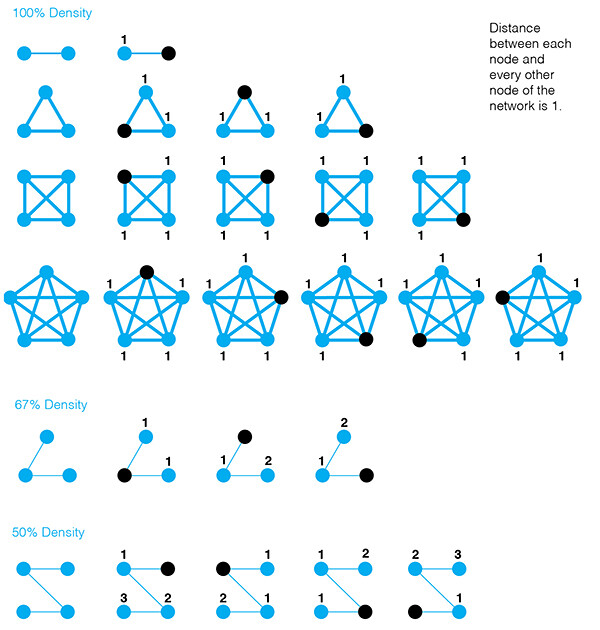

Network distances in networks of varying densities. Image by Center for Spatial Research, 2020.
Difference and Bridging Ties
Smith is one of many authors who have deployed Granoveter’s analysis to think about connections between distant and different nodes. Years earlier, in 1983, in a paper titled “The Strength of Weak Ties: A Network Theory Revisited,” Granovetter responded to criticisms and extensions of his work. He stresses that what he had called “strong” weak ties are in fact “bridges”: “the argument of [“The Strength of Weak Ties”] implies that only bridging weak ties are of special value to individuals; the significance of weak ties is that they are far more likely to be bridges than are strong ties.”32
Granovetter explains that a bridge is a “line in a network which provides the only path between two points,” meaning that these two points (or people) do not have any other overlapping connections.33 All bridges are weak ties, but not all weak ties are bridges. Bridging weak ties are valuable in that they can connect nodes whose networks do not overlap.
Drawing on Rose Coser’s work on elaborated codes and the development of individual autonomy, Granovetter suggested that “bridging ties, since they do link different groups, are far more likely than other weak ties to connect individuals who are significantly different from one another.”34 Granovetter here refined his initial definition of weak ties—measured in terms of the “amount of time, the emotional intensity, the intimacy (mutual confiding), and the reciprocal services”—with an explicit recognition of the function, or their potential, to “connect individuals who are significantly different from one another.” Revisiting the example from Boston, he speculates that West Enders lacked:
the sort of ties that lead to complex role sets and the need for cognitive flexibility. The absence of flexibility may have inhibited organization against urban ‘renewal,’ since the ability to function in complex voluntary organizations may depend on a habit of mind that permits one to assess the needs, motives, and actions of a great variety of people simultaneously.35
While still problematically blaming working class people for their own displacement, Granovetter here opened a paradigm of thinking beyond close neighborhood clusters, or the notion that we have our strongest friendships or links with people who are or think or act like us.36 What is key is that weak ties are generally just that: weak. What Granovetter calls their strength comes about when they are activated, when the bridges they constitute between otherwise separated spaces and people are put to use, realized, operationalized. Those historical, political, actions do not happen automatically; they are not merely a function of the existence of a network that can be diagrammed. Information only flows across them when agents take action to make it flow, to send and to respond. Weak ties are not a form of friendship or love, but rather of acquaintance or passing relation. If social networks have spread friendship by emptying it of its initial affective intensity, the concept of weak ties returns us to neighbors, acquaintances, and ambivalence.
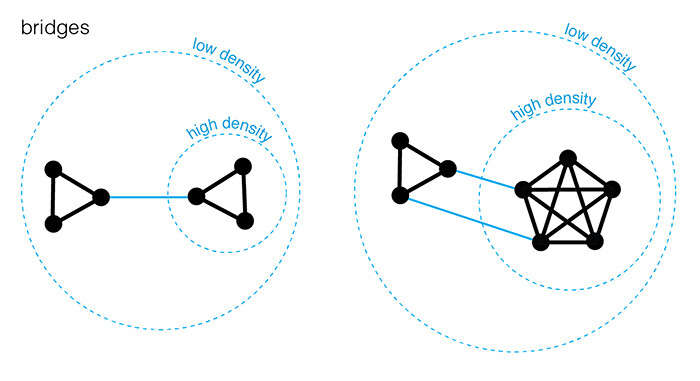

Bridging ties. Image by Center for Spatial Research, 2020.
Weak ties are perhaps analogous to neighborly relations, “nodding neighbors” who live on the same street, or vendors from whom one normally buys daily items, which Granovetter classifies as “absent” relations.37 Indeed, weak ties offer the opportunity to address what network graphs ignore: empty space, or the distances that require bridging. As Kenneth Reinhard, drawing from Hannah Arendt, has argued, neighbors—who are neither friends nor enemies—make the space of community and allow the (sense of what’s) public and private to emerge.38 This does not mean, however, that neighbors are innocuous. They can be nosy and noisy. Weak ties thus offer a possibility to think through the historically competing imaginaries of neighbors and friends. To open this chapter, though, it is crucial to address the questions of class, race, and hierarchy that haunt weak ties, and are present in most other instances of urban “renewal.”
It is significant that Granovetter framed “The Strength of Weak Ties” as a response to urban “renewal,” which occurred only in communities depicted as “slums.” Granovetter’s examples stress the difference in weak ties among members of different communities and as central to communication across those differences. Weak ties—viewed only as bridges—keep in place homophilic clusters, even as they bridge them. A structuralist analysis of social networks obscures both the transactional and distant nature of the weak tie, as well as where and what motives lie behind its activation. It glosses over agency and the modes that might put them to work; they can ignore the interdependence of urban space and network space. And yet in the possibility of fostering, of finding strength in connections across difference, weak ties offer a pragmatic starting point to address our divided physical and digital social worlds.
Mark S. Granovetter, “The Strength of Weak Ties,” American Journal of Sociology 78, no. 6 (1973): 1361.
Eytan Bakshy et al., “The Role of Social Networks in Information Diffusion,” in Proceedings of the 21st International Conference on World Wide Web, WWW ’12 (Lyon: Association for Computing Machinery, 2012), 519–528, ➝.
See Laura Kurgan et al., “Homophily: The Urban History of an Algorithm,” e-flux Architecture, October 2019, ➝; Clemens Apprich, Wendy Hui Kyong Chun, Florian Cramer, and Hito Steyerl, Pattern Discrimination (Lunenburg: Meson, 2018).
For representative examples of the prevailing approach in urban sociology, see: Mark E. J. Newman, Networks: An Introduction (Oxford: Oxford University Press, 2018); Louis Wirth, “Urbanism as a Way of Life,” American Journal of Sociology 44, no. 1 (1938): 1–24.
Granovetter, “The Strength of Weak Ties.”
Ibid.
Ibid.
Langley Carleton Keyes, The Rehabilitation Planning Game: A Study in the Diversity of Neighborhood (Cambridge: MIT Press, 1969).
Granovetter, “The Strength of Weak Ties,” 1375. Charlestown, according to the 1950 U.S. Census, is similarly majority white, with 98.69% of residents being white, comparable with the West End which has 98.76% white residents. These neighborhoods have slightly higher percentage of white residents than the city of Boston as a whole (95.19%).
Ibid.
Herbert J. Gans, The Urban Villagers; Group and Class in the Life of Italian-Americans (New York: Free Press of Glencoe, 1962), xv.
Ibid., 323.
Ibid.
It is worth noting that in The Urban Villagers, Gans discloses that he had considered quitting the research to join the efforts of the Save the West End Committee which struggled to mobilize against the relocation. Gans’s discomfort comes through in the book, and the lengthy study he submits to the Boston Housing Authority entitled “An Analysis of Redevelopment and Relocation Planning for the West End of Boston,” reproduced in the book. But perhaps it can be more deeply understood from letters to his activist-interlocutor Joe Caruso, preserved in The Herbert Gans Papers at the Rare Books and Manuscripts Library at Columbia University. In these exchanges, Gans urges Caruso to continue to cooperate with the Harvard team contributing to research on the West End, constantly negotiating the instrumentalizing logic of his work, that by accepting the demise of the neighborhood he can contribute to a ground-breaking study introducing the psychology of a vulnerable population facing relocation to a traditional medical audience. It is this context that must be reaffirmed when understanding Gans’s positionality towards the West End.
Writing also on the West End study Chester Hartman gives context for this comparison between the patterns of life among West Enders and those of a typical middle class household when he writes: “‘Slum’ is a loaded, often class-biased term, oblivious to or ignorant of different, and legitimate, ways in which indoor and outdoor spaces are used and perceived.” By studying the West End in its own terms, we should understand Gans’s project as in part a critique of the predominant assumptions undergirding most urban planning at the time which aimed to obliterate forms of everyday life that did not neatly fit within white middle class frames of reference. Chester W. Hartman, Between Eminence and Notoriety: Four Decades of Radical Urban Planning (New Brunswick: Center for Urban Policy Research, 2002).
Gans, The Urban Villagers, 39.
Herbert J. Gans, “Gans on Granovetter’s ‘Strength of Weak Ties,’” American Journal of Sociology 80, no. 2 (1974): 524–27.
Samuel Zipp, “The Battle of Lincoln Square: Neighbourhood Culture and the Rise of Resistance to urban renewal,” Planning Perspectives 24, no. 4 (October 1, 2009): 409–33.
Boston City Planning Board, General Plan for Boston: Preliminary Report, December, 1950 (Boston: City Planning Board, 1950), 39.
Ibid., 42.
Ibid., 43.
See Gans, The Urban Villagers; Boston Housing Authority, The West End Project Report: A Redevelopment Study (Boston: Boston Housing Authority, 1953), ➝.
Berman v. Parker, 348 U.S. 26 and Wendell E. Pritchett, “The ‘Public Menace’ of Blight: Urban Renewal and the Private Uses of Eminent Domain,” Yale Law & Policy Review 21, no. 1 (2003): 1–52.
Zipp, “The Battle of Lincoln Square.”
Jane Jacobs, “Foreword,” in Hartman, Between Eminence and Notoriety, xiii.
Gans, “Gans on Granovetter’s ‘Strength of Weak Ties.’”
Gans, The Urban Villagers, 104–105.
In his definition of the strength of interpersonal ties, Granovetter notes that “ties discussed in this paper are assumed to be positive and symmetric; a comprehensive theory might require discussion of negative and/or asymmetric ties, but this would add unnecessary complexity to the present, exploratory comments.” Granovetter, “The Strength of Weak Ties.”
Ibid., 1378.
Sandra Susan Smith, “‘Don’t Put My Name on It’: Social Capital Activation and Job‐Finding Assistance among the Black Urban Poor,” American Journal of Sociology 111, no. 1 (2005): 3.
“Introduction,” in The Structure and Dynamics of Networks, eds. Mark Newman, Albert-László Barabási, and Duncan J. Watts (Princeton: Princeton University Press, 2006), 1–8, ➝.
Mark Granovetter, “The Strength of Weak Ties: A Network Theory Revisited,” Sociological Theory 1 (1983): 208.
Granovetter, “The Strength of Weak Ties,” 1364.
Granovetter, “The Strength of Weak Ties: A Network Theory Revisited,” 204.
Ibid., 204–205.
In our previous work, we revealed that homophily emerged from analyses of white residents’ attitudes to bi-racial housing projects within the U.S.–projects which were similarly part of “slum clearance” efforts. Sociologists Paul Lazarsfeld and Robert Merton coined both homophily and heterophily, in “Friendship as Social Process” they focused exclusively on measuring and explaining homophily within “Hilltown.” According to Lazarsfeld and Merton, gender and race-homophily was almost 100% in Hilltown. Based on the answers to three questions—“who are your three closest friends?”; “do you think public housing should be bi-racial?” and “do you think that the races get along in Hilltown”—they argued that values drove homophily. Liberal, where liberal meant those who believed that housing projects should be bi-racial and the races got along, over-selected liberals; and illiberals, where illiberals responded no to these questions, overselected illiberals as close friends. To make this argument, they ignored the responses of all the black residents and the white ambivalents, those who believed that projects shouldn’t be bi-racial but admitted that the races did get along—the largest category of white residents. Born in a housing project, and built on the premise of (bridging) racial difference, the concept they coined and theorized has gone on to play a decisive role in network analysis and science ever since. What started as a description of social life, has become an axiom, and now, a prescription through the algorithms which design our social media environments: we are, and supposedly want or even ought to be, connected to those who are similar to us. For more on this work, see: Kurgan et al., “Homophily,” 2019; Apprich et al., Pattern Discrimination.
Granovetter, “The Strength of Weak Ties,” 1361.
Kenneth Reinhard, “Toward a Political Theology of the Neighbor,” in The Neighbor: Three Inquiries in Political Theology, eds. Slavoj Žižek, Eric L. Santner, and Kenneth Reinhard (Chicago: University of Chicago Press, 2005).
Are Friends Electric? is a collaboration between e-flux Architecture and Moderna Museet within the context of its exhibition Mud Muses: A Rant about Technology.
Category
Subject
The authors would like to thank Nadine Fattaleh, Tola Oniyangi, and Audrey Dandenault for their instrumental archival research in the beginning stages of this project. Support for this research was also provided by the Andrew W. Mellon Foundation as part of their Architecture, Urbanism, and the Humanities Initiative.
Are Friends Electric? is a collaboration between e-flux Architecture and Moderna Museet within the context of its exhibition Mud Muses: A Rant about Technology.

